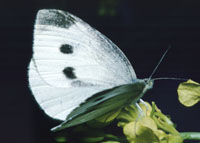%20EXOTIC/Crystal%20Cove%20State%20Beach,%20Laguna%20Beach,%20CA.%201-28-12%20051.jpg) The brightly colored flowers have 5 petals; 8 stamens; 5 sepals, with a 1 in. nectar spur, a part of the sepal at the rear. Colors range from yellow to red. Crystal Cove State Beach, Laguna Beach, CA. 1-28-12. © Joan Avise. |
Garden Nasturtium Tropaeolum majus Exotic, native to the Andes of South America. It is an occasional escapee from cultivation in moist areas near residential development, especially near the coast (e.g. Upper Newport Bay, Crystal Cove State Park). The only local representative the single-genus family Tropaeolaceae. The 2 cm. fruit has 3-segments, each with a single large seed. Usually only one large ribbed seed matures (Clarke). Nasturtiums produce an oil that is similar to that produced by Watercress (Nasturtium officinale) in the family Brassicaceae, hence the common name. Flowers and foliage are edible, often used in salad. Flowering: year round. Other uses Back to Tropaeolaceae of Orange County, California |
%20EXOTIC/Crystal%20Cove%20State%20Beach,%20Laguna%20Beach,%20CA.%201-28-12%20053.jpg) The large, circular leaf has a long petiole near the middle, and several veins radiating to the smoothly rounded or lobed margin. Crystal Cove State Beach, Laguna Beach, CA. 1-28-12. © Joan Avise. |
%20EXOTIC/Crystal%20Cove%20State%20Beach,%20Laguna%20Beach,%20CA.%20%201-28-12%20054.jpg) It is annual or perennial, with trailing stems growing up to 3 ft.long, forming a ground cover that can climb over other plants. Crystal Cove State Beach, Laguna Beach, CA. 1-28-12. © Joan Avise. |
| Associations with insects | |
Tropaeolum species are used as food plants by the larvae of some moths and the caterpillar of the Cabbage White Butterfly, often found on Nasturtiums in particular. |
|
